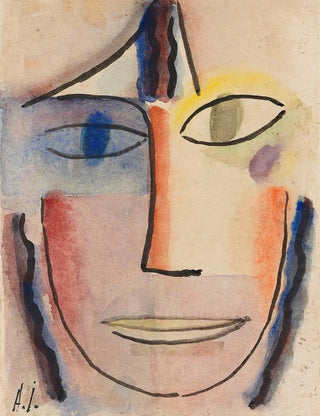Art print | Female head Femina - Alexej von Jawlensky Source: Reproduction | Tête de femme Femina - Alexej von Jawlensky


View from behind

Frame (optional)
In the vast panorama of modern art, certain works stand out for their ability to capture the very essence of human emotion. "Head of a Woman Femina" by Alexej von Jawlensky is one of those creations that transcend mere visuals to become a true exploration of the soul. This piece, with its stylized forms and vibrant colors, invites the viewer on an introspective journey. The depiction of a female face, both enigmatic and familiar, evokes unwavering fascination. It suggests feelings of tenderness, mystery, and depth, while aligning with the Expressionist movement that marked the early 20th century.
Style and uniqueness of the work
The uniqueness of "Head of a Woman Femina" lies in Alexej von Jawlensky's bold style, which combines abstraction and figuration. The facial features, though simplified, retain an emotional intensity that captures attention. The colors, carefully chosen, oscillate between warm and cool tones, creating a striking contrast that enhances the visual impact of the piece. Jawlensky uses a vibrant palette to convey sensations rather than physical realities, inviting the viewer to feel rather than merely observe. This unconventional approach allows the work to evoke universal themes such as beauty, solitude, and introspection, while leaving room for personal interpretation.
The artist and his influence
Alexej von Jawlensky, an emblematic figure of Expressionism, made his mark through his innovative approach and exploration of human emotions. Born in Russia, he moved to Germany where he mingled with other great artists, such as Wassily Kandinsky and Gabriele Münter. Together, they contributed to the emergence of a new artistic language, freeing color and form from traditional constraints. Jawlensky was particularly influenced by religious icons and folk art, which is reflected in the palpable spirituality of his works. His ability to fuse tradition and modernity paved the way for new artistic currents.

Matte finish

View from behind

Frame (optional)
In the vast panorama of modern art, certain works stand out for their ability to capture the very essence of human emotion. "Head of a Woman Femina" by Alexej von Jawlensky is one of those creations that transcend mere visuals to become a true exploration of the soul. This piece, with its stylized forms and vibrant colors, invites the viewer on an introspective journey. The depiction of a female face, both enigmatic and familiar, evokes unwavering fascination. It suggests feelings of tenderness, mystery, and depth, while aligning with the Expressionist movement that marked the early 20th century.
Style and uniqueness of the work
The uniqueness of "Head of a Woman Femina" lies in Alexej von Jawlensky's bold style, which combines abstraction and figuration. The facial features, though simplified, retain an emotional intensity that captures attention. The colors, carefully chosen, oscillate between warm and cool tones, creating a striking contrast that enhances the visual impact of the piece. Jawlensky uses a vibrant palette to convey sensations rather than physical realities, inviting the viewer to feel rather than merely observe. This unconventional approach allows the work to evoke universal themes such as beauty, solitude, and introspection, while leaving room for personal interpretation.
The artist and his influence
Alexej von Jawlensky, an emblematic figure of Expressionism, made his mark through his innovative approach and exploration of human emotions. Born in Russia, he moved to Germany where he mingled with other great artists, such as Wassily Kandinsky and Gabriele Münter. Together, they contributed to the emergence of a new artistic language, freeing color and form from traditional constraints. Jawlensky was particularly influenced by religious icons and folk art, which is reflected in the palpable spirituality of his works. His ability to fuse tradition and modernity paved the way for new artistic currents.






